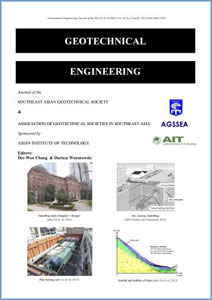Lime Stabilisation of Organic Clay and the Effects of Humic Acid Content
Main Article Content
Abstract
The effectiveness of lime as a chemical additive for the stabilisation of organic clay is considered uncertain, especially in the long term. The presence of humic acid is believed to be the main detrimental constituent of organic matter that renders lime stabilisation inefficient. In this paper, the amount of humic acid that may render lime stabilisation inefficient was carefully investigated. Artificial organic clay, prepared by mixing commercial kaolin and various amounts of humic acid (0.5%, 1.5% and 3.0%) was treated with hydrated lime. The strength properties of lime-treated organic clays were examined by unconfined compressive strength (UCS) and drained and undrained triaxial compression tests. Curing periods of 7, 28 and 90 days were chosen as key points to monitor the evolution and the effect of the stabilisation process on lime-treated specimens. Overall, the development of physical and engineering properties of lime-treated organic clay was most affected when the humic acid content in clay exceeded 1.5%.
Article Details

This work is licensed under a Creative Commons Attribution-NonCommercial-NoDerivatives 4.0 International License.
Copyright © 2019 Association of Geotechnical Societies in Southeast Asia (AGSSEA) - Southeast Asian Geotechnical Society (SEAGS).


